
New to our range

Even with its new design, the Fairphone (Gen. 6) remains a sustainable and easy-to-repair smartphone. It also stands out from other mid-range smartphones thanks to its accessories, a sliding switch and Fairphone Moments.
To me, the Fairphone 5 was the first model from the manufacturer where sustainability didn’t come at the expense of usability. This still applies to the Fairphone (Gen. 6). With a new design, screw-on accessories and Fairphone Moments – a new personalised mode that turns the smartphone into a dumbphone – the manufacturer is trying to tap into new target groups. Sustainability is still important, but it’s no longer the only argument for buying this smartphone.
Visually, the Fairphone (Gen. 6) represents a major change. My test device is still forest green, but there’s also a white and a black version. In addition, the shape has changed more than that of any other Fairphone generation. Unlike its predecessor, however, I need to grab a screwdriver to replace the battery. The back of the Fairphone 5 can be opened without tools. On the new Fairphone, screws are also used to attach accessories, which I’ll come to later.
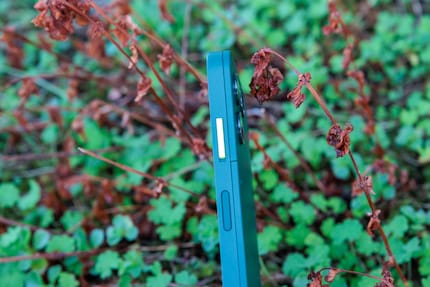
The Fairphone (Gen. 6) is now protected against splashing water according to IP55 and has withstood drop tests to various standards from heights of 1.5 and 1.8 metres. The display is protected by Gorilla Glass 7i, said to be twice as scratch-resistant as the glass on its predecessor.
A slight indentation is noticeable at the bottom on the back. You can feel it with your fingers, and it provides a little more support depending on the grip position. In addition, a slider contrasting in colour, which Fairphone calls the Switch, stands out on the right-hand side above the power button. It activates Fairphone Moments by default. Alternatively, it can switch on flight mode, the flashlight, power saver mode or Do not disturb, on top of shifting between light and dark mode.
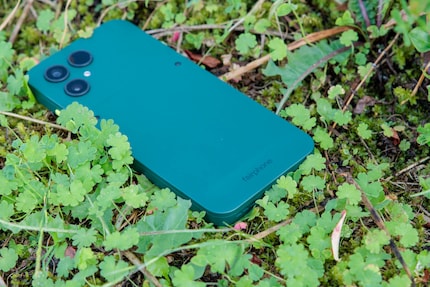
With Fairphone Moments, the smartphone offers an option to customise for different occasions. You can create different profiles or scenarios, say for work, a quiet evening or holiday. There, I can select which apps are available to me and which are allowed to send me notifications. I can also specify who’s allowed to call me and how long it takes for callers to get through to me on a second or third attempt. I can also use individual background images to give each moment its own look and feel.
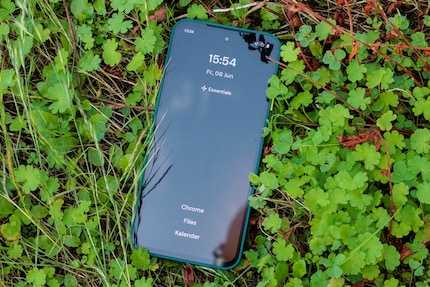
Android 15 comes installed by default on the X30 Pro. The Fairphone app is the only novelty aside from Fairphone Moments. It can be used, for example, to order spare parts or find repair instructions. As with its predecessor, Fairphone continues to make the longest update promise around. Updates for the Fairphone 6 are to be released until 2033, i.e. for eight years. For top devices from other manufacturers such as Samsung or Google, it’s only seven years. The CMF Phone 2 Pro and Nothing Phone (3a) mentioned here later only receive three years of Android updates – and six years of security updates, at least.
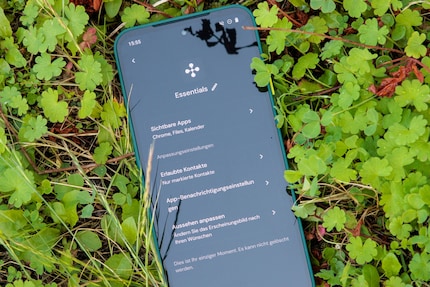
Fairphone and Murena again offer the Fairphone (Gen. 6) with /e/OS as a Google-free operating system.
Despite its new design, the Fairphone (Gen. 6) is still manufactured under fair working conditions. All wages are supposedly high enough for people to live on. The smartphone also consists of 50 per cent fairly sourced or recycled raw materials. Especially when it comes to recycling, many other manufacturers have followed suit since the first Fairphone, so the Fairphone is no longer as special in this respect.
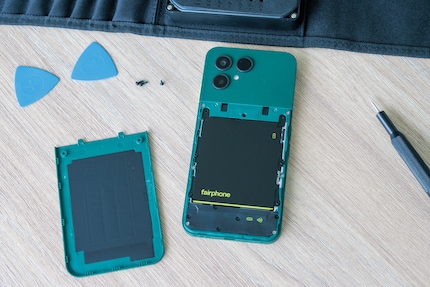
Fairphone also offers spare parts for its sixth smartphone. A total of twelve components are provided for DIY home replacement: the battery, display, ear speaker, USB-C port, all three cameras, the bottom unit and the speaker as well as the top and bottom half of the back. Fairphone also includes a holder for SIM and microSD cards. The processor and memory are permanently attached to the housing and can’t be replaced.
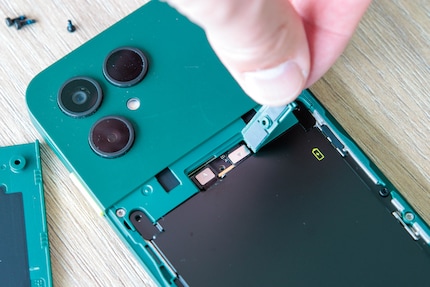
Unlike its predecessor, the back of the Fairphone (Gen. 6) can’t be opened without tools. I need to use a small Torx screwdriver to loosen the two screws and then slide the lower part of the back down. The battery itself is attached by four screws. I have to loosen another one to get to the plug connection for the power supply. With the Fairphone 5, on the other hand, I was able to remove and reinsert the battery without tools. It also worked with contact points, not a plug connection. Not that this is really relevant when you’re replacing the battery after several years.
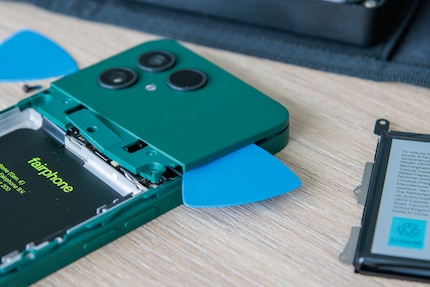
To loosen the upper part of the back, I use the Opening Pick. I can use it to lift the cover out of its anchoring. After that, I loosen eight screws to access the components in the upper area. The lower unit is fastened with seven screws. I managed to replace the display on the front simply by removing the eight silver screws. I was able to leave the shorter, black screws in place in this case.
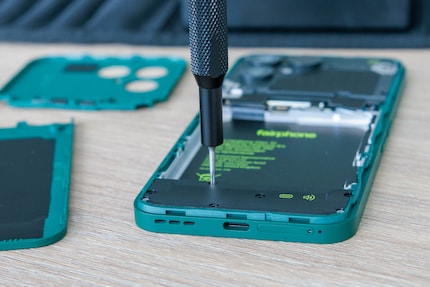
Although Fairphone has made it more difficult to replace the battery with a total of seven screws, the fact remains that no smartphone is as easy to repair at home as a Fairphone.
There’s a wide range of accessories available for the Fairphone (Gen. 6). A flip case and protective cover as well as two protective films – normal and with privacy protection – are pretty common. However, a card holder, finger loop and lanyard, which I can screw onto the back, aren’t standard on other smartphones. Several accessories can also be combined, say the protective cover, neck strap and finger holder. A small screwdriver and screws are included with the back elements and the lanyard.
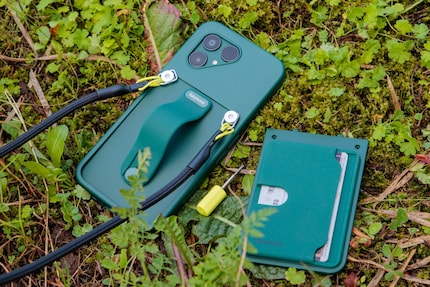
Mounting accessories using screws reminds me of the CMF Phone, which worked on the same principle. On the iPhone, similar accessories can be added magnetically on the back.
With its 6.31-inch OLED display, the Fairphone (Gen. 6) is comparatively compact. Sporting a resolution of 2484 × 1116 pixels and a refresh rate that can be manually set to 60, 90 or 120 hertz, it looks pretty satisfying. The typical brightness of 800 nits – eight per cent more than the Fairphone 5 – is enough to use the smartphone easily in sunny conditions.
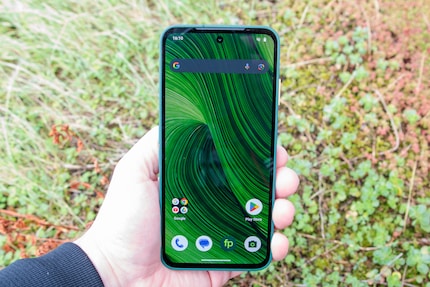
The Fairphone 6 is equipped with the Snapdragon 7s Gen 3. It’s supported by eight gigabytes of working memory. Compared to its predecessor with a QCM 6490, unusual for smartphones, it’s a clearly measurable improvement. The CMF Phone 2 Pro with its Mediatek Dimensity 7300 Pro 5G is also clearly outperformed by the Fairphone 6. Unsurprisingly, it’s on a par with the Nothing Phone (3a), also equipped with the Snapdragon 7s Gen 3.
The new Fairphone has 256 gigabytes of storage space, which can be expanded using a microSD card.
At 4,415 mAh, the battery of the Fairphone 6 is larger than that of the Fairphone 5 – 4,200 mAh. However, it’s still around ten per cent off the average smartphone. They’ve currently settled in at around 5,000 mAh, but are generally not replaceable.
This low battery capacity is also noticeable in the service life. PCMark 3.0’s battery test determines an active usage time of 8:05 hours. That works for everyday use, but is less than most other smartphones offer. They now regularly reach over ten hours in the same test. The Fairphone 6 still has room for improvement here.
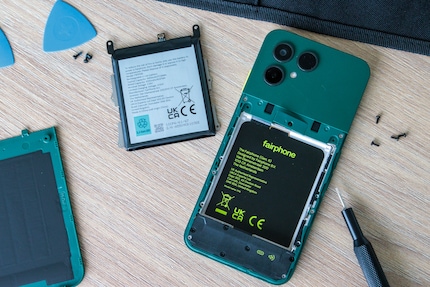
The Fairphone 6 is charged via USB-C, accepting up to 30 watts. This isn’t as fast as other smartphones, but still decent. The battery is 50 per cent full after just 25 minutes. After that, the charging speed slows down, as with all devices, taking another hour or so to fully fill the battery.
The Fairphone (Gen. 6) has two cameras on the back. You get a 50-megapixel main camera and a 13-megapixel ultra-wide-angle camera. The front-facing camera has a resolution of 32 megapixels. Due to a lack of any telephoto camera, there’s only digital zoom and no optical telephoto focal length.
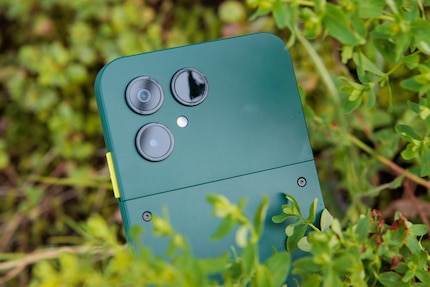
The final camera software isn’t yet installed on my test device. However, it already provides usable photos. The main camera offers a high level of detail and natural colour reproduction. Only in a few pictures do I get the feeling that there’s a little too much yellow around.

The dual digital zoom offered in the camera app is also easy to use.
The ultra-wide-angle camera also impresses in daylight. In the dark, night mode leads to increased detail and focus over the standard main camera.
The front camera still has some problems with bright sunlight. After one final update, I’ll see if I notice any improvements and make a note of them here.

The Fairphone (Gen. 6) doesn’t set new standards in photography. However, it offers solid usable image quality for occasional photographers day and night.
Like its predecessor, the Fairphone (Gen. 6) is a decent mid-range smartphone. You don’t have to compromise on sustainability, and with a recommended retail price that’s fallen by 100 euros/francs at that. Compared to the Fairphone 5, there are numerous improvements, yet some users report a worse off screwed-in battery.
With Fairphone Moments, the new switch and extra accessories, the new Fairphone also stands out from the crowd of smartphones. I also like the new design.
Compared to other, generally cheaper, conventional mid-range smartphones, I particularly notice the lack of a telephoto camera and the short battery life. However, they don’t stop the Fairphone (Gen. 6) from being well suited for everyday use. For more money, you can also get a very long update period and spare parts available for replacement at home far into the future.
Pro
Contra
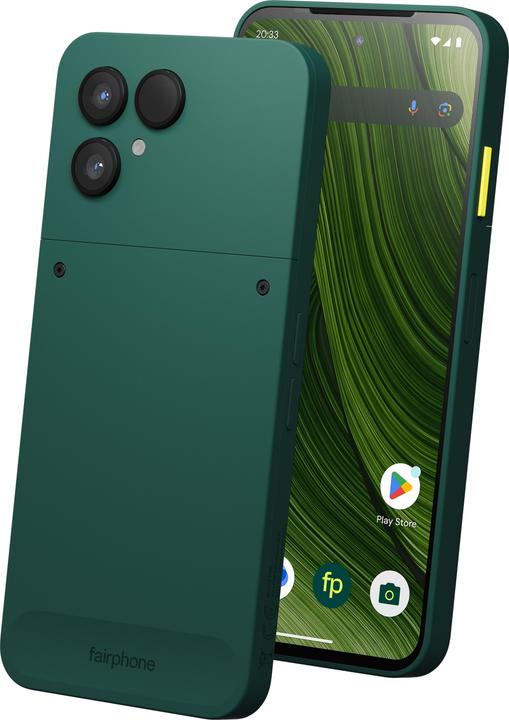

Fairphone (Gen. 6)
256 GB, Forest Green, 6.31", SIM + eSIM, 5G
As a primary school pupil, I used to sit in a friend's living room with many of my classmates to play the Super NES. Now I get my hands on the latest technology and test it for you. In recent years at Curved, Computer Bild and Netzwelt, now at Digitec and Galaxus.